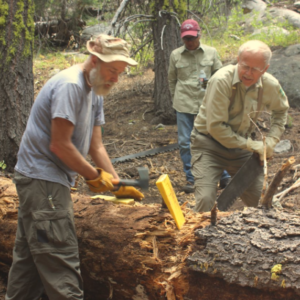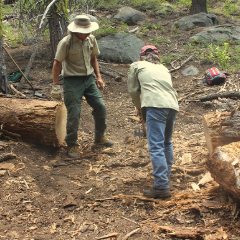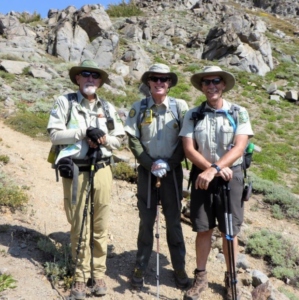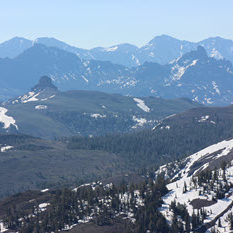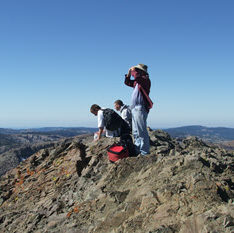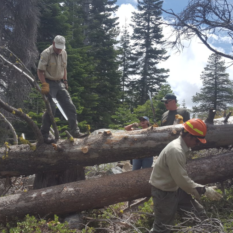THINGS TO KNOW BEFORE VISITING
No matter whether you are visiting for just a few hours or backpacking in the wilderness for multiple days, always be sure to have the 10 Essentials for safety in the outdoors with you.
Extra Water
Water, filtration device
Navigation
Map, compass, altimeter, GPS device, satellite messenger.
Flashlight or Headlamp
Include extra batteries
Sun Protection
Sunscreen, protective clothing, sunglasses
First Aid
Items to treat minor injuries, bug spray, moleskin
Knife
Can include leatherman or another similar tool
Matches
Fire starter, lighter
Emergency Shelter
Space blanket
Extra Food
Additional nutrition for unexpected delays
Extra Clothing
Mountain weather can change rapidly
What is a Wilderness Area?
The National Wilderness Preservation System is a network of over 111.7 million acres – more area than the state of California – of public land comprised of more than 803 wilderness areas administered for the American people by the federal government. These are special places where nature still calls the shots. Places where people like you, with an appetite for adventure, can find a sense of true self-reliance and experience solitude. They are final holdout refuges for a long list of rare, threatened, and endangered species, forced to the edges by modern development. They are the headwaters of critical, life-infusing rivers and streams. They are places where law mandates above all else that wildness be retained for our current generation, and those who will follow.
“If future generations are to remember us with gratitude rather than contempt, we must leave them a glimpse of the world as it was in the beginning, not just after we got through with it.”
– Proclaimed by President Lyndon B. Johnson upon his signing of The Wilderness Act, September 3rd, 1964
“…I am glad I shall never be young without wild country to be young in. Of what avail are forty freedoms without a blank spot on the map?”
Aldo Leopold, A Sand County Almanac (1949)
Where is the Mokelumne Wilderness?
The Mokelumne Wilderness straddles the crest of the central Sierra Nevada, within the Stanislaus, Eldorado, and Humboldt-Toiyabe National Forests. Located south of the Lake Tahoe Basin, this area lies within portions of Calaveras, Alpine, and Amador Counties and is bordered by Highway 4 on the south and Highway 88 on the north. The Mokelumne Wilderness is a rugged landscape of great scenic beauty. Much of the area is dominated by volcanic ridges and peaks. Many small streams flow through deep granitic canyons but only a few lakes are concentrated in the northern portion of this spectacular area. Elevations range from about 3900 feet near Salt Springs Reservoir to 10,380 feet at Round Top. Precipitation averages 50 inches annually on the west slope and as little as 15 inches on the east slope, 80 percent of it in the form of snow. Snowcaps typically linger into June in the Round Top region to the north and on the Mokelumne Plateau to the south, while the Mokelumne River Canyon above Salt Springs Reservoir can be free of snow as early as March. Summers are generally dry and mild, but afternoon thundershowers occur periodically and nighttime temperatures may dip below freezing anytime.
What is the Mokelumne Wilderness Volunteer Program?
The Mokelumne Wilderness Volunteer program is one small piece of a nationwide program which provides affordable and meaningful volunteer service opportunities that conserve and protect America’s wild lands. Volunteers are trained by and work in cooperation with the US Forest Service to offer stewardship, education and information to Wilderness visitors.
How big is the Mokelumne Wilderness?
Designated in 1964, the 105,165 acre Mokelumne Wilderness straddles the crest of the central Sierra Nevada, within the Stanislaus, Eldorado, and Humboldt-Toiyabe National Forests. This area is bordered by State Highway 4 on the south and State Highway 88 on the north.
Is the Carson Pass Management Area in the Mokelumne Wilderness?
Yes, some of the Carson Pass Management Area is within the Mokelumne Wilderness area and there are different rules for camping due to the impact from large numbers of outdoor enthusiasts. This area requires a permit for use in a limited number of designated campsites, no fires are allowed in the Carson Pass Management Area and dogs must be on a leash at all times.
Can I camp in the Carson Pass Management Area?
Yes, but only in designated campsites around Lake Winnemucca, Round Top Lake and 4th of July Lake. There is no camping allowed otherwise inside of the Carson Pass Management Area, including Frog Lake. Along with a permit for a campsite for up to 3 nights there are no fires allowed anywhere within the Carson Pass Management Area. All dogs must be on a leash at all times.
What permits do I need to visit the Mokelumne Wilderness?
No permit is necessary for day trips anywhere in the Wilderness, although groups must be no greater than 12 people. Camping within the Carson Pass Management Area is only allowed with a permit for designated campsites only. Overnight stays anywhere else in the Wilderness requires a (free) permit and is limited to 8 people per group.
How do I get an overnight permit for the Mokelumne Wilderness
Navigate to https://www.fs.usda.gov/Internet/FSE_DOCUMENTS/fseprd754168.pdf to obtain the Permit that will allow you to fill out and submit it for your upcoming overnight stay in the Mokelumne Wilderness. Any overnight permit is limited to 8 people per group.
Do I need a bear cannister while camping in the Mokelumne Wilderness?
A bear cannister is not currently required within the wilderness but is recommended for safe storage of food and any scented items from all types of interested wildlife.
Can I have a campfire in the Mokelumne Wilderness?
A wilderness permit is required for entry and a campfire permit is required for a campfire. Campfires are prohibited above 8,000 feet, within the Carson Pass Management Area, in the North Fork Mokelumne River Canyon along Salt Springs Reservoir, and along the Blue Hole Trail.
What rules should I be aware of while in the Mokelumne Wilderness?
Travel is restricted to horseback or foot only. All means of mechanical transportation, including bicycles, are prohibited in wilderness. Wheelchairs are allowed. Visitors are required to bury human waste 6 to 8 inches deep and at least 200 feet away from water, trails, and campsites. Toilet paper must be buried or packed out. Garbage must be packed out. Maximum group size 12 people for day use, and 8 people for overnight use. Domestic pets are allowed in the Mokelumne Wilderness at this time. The Amador and Alpine County leash laws are enforced inside the Wilderness Boundary.
When is the best time to view wildflowers in the Mokelumne Wilderness?
Carson Pass is one of the best places in California to view amazing displays of wildflowers in the summertime. Exactly when these displays may reach their peak vary from year to year. In general, peak viewing times will be somewhere between mid to late June and early August. During dry years this can be sooner and during wet years this may be later. The trails from Carson Pass to Lake Winnemucca and from Woods Lake to Round Top Lake are often reward visitors with prolific displays.
